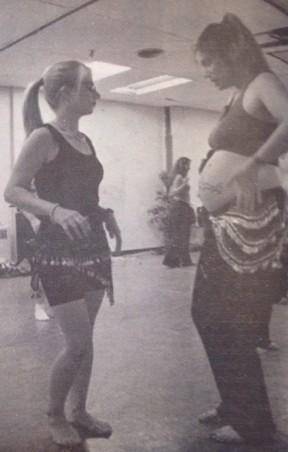By Katia Lioshiz
The golden coin tassels on their hip shawls rattle and chime as they dance. The women thrust and sway their hips gracefully, yet aggressively. Their shoulders create a sense of fluidity that emphasizes the upper body. The smiles don’t seem to leave their faces as they dance for themselves only, doing the shimmy (a basic rapid shake of the hips or the shoulders) and the delicate gamal arms (snakelike movements). These women, of all sizes, shapes and ethnicities, have embraced the refined and historical art of belly dancing.
For many, the dance is liberating and helps women achieve a healthier body image through the sexual dance moves.
“It’s a sensual dance, there’s no doubt about it,” says Yasmina Ramzy, artistic director, choreographer and founder of Arabesque Academy, a belly dance school in Toronto.
Although it’s not known exactly when the belly dance originated, it’s still part of Arabic cultures in countries such as Egypt, Syria and Lebanon. The belly dance has lately become popular in North America, performed by the likes of Britney Spears and Shakira.
The dance is mostly known as Raks Sharqi, or Oriental Dance. Nineteenth century French travellers, who were introduced to the dance on their trip to the Middle East, named it danse du ventre, or dance of the stomach, alluding to the movements women make with their hips and pelvises when dancing.
For centuries, women of the Middle East have been performing a dance that many European, North American and Muslim cultures still regard as shameful and vulgar because of the sexual suggestiveness of the dance moves.
“Many other cultures don’t understand the dance,” says Ramzy, who has danced professionally for the past 22 years and has travelled and performed in many countries in the Middle East.
“Canadians think they should put money into your costume,” she says, referring to the way men are encouraged to react to an exotic dancer in a strip club. But it is not exotic dancing — it’s more subtle than that.
Ramzy explains that Arabs have a greater respect for belly dancers and their hard work because it is part of their culture. The costume is designed to show the movements better.
“It’s like wearing a bathing suit at the beach — if you’re going swimming, people are going to look at you.”
Ramzy meets many women who want to learn how to belly dance for different reasons. She explains that some start by wanting to lose weight but others are attracted to Arabic Culture, the drum beats, and the costumes. Whatever the goal, most women leave the class happy.
“They perform movements they’ve been taught to be ashamed of,” Ramzy says.
She explains you don’t have to look a certain way to be a good dancer. Women who weigh more tend to stay closer to the ground when dancing, which is a major bonus when performing the belly dance.
The Middle Eastern cultures are not the only ones that encourage women to dance and move their bodies to express themselves. For other cultures and different dancers, a distinctive style of music also allows women to retreat to Hawaii.
Siony Srnka is a Hawaiian Hula dance teacher in the Toronto area. She says that various cultural women’s dances help women achieve a better self-image.
“It’s most important to do what you love and have the guts to do it,” says Srnka. “[Dancing] helps women feel young and health, mentally and physically. They love to do it.”
She also explains that Hula dancing makes the dancers’ brains work, since they are taught to memorize lyrics and sing and dance simultaneously to the beat of the drums.
The belly dance and Hawaiian Hula both require the dancers to dance barefoot, sometimes wearing comfortable but somewhat revealing costumes that emphasizing the movements of the hips and torso.
Shira Stern, administrative co-ordinator at Ryerson’s Women’s Centre, agrees that belly dancing can help many women achieve a healthier body image.
“It’s a reclamation of confidence and sexuality in women of all sizes,” she says. “There are way too many messages that we receive on a regular basis that are negative about our bodies.”
Tyechia Harris, an 18-year-old belly dancer, is reaping the benefits, since she started dancing over a year ago.
“I feel better about this now,” she says, pointing to her midriff and smiling. “I can do this.” She does a belly roll, moving her abdomen inward and outward sensually. “Big hips and stomach are in,” she says.











Leave a Reply